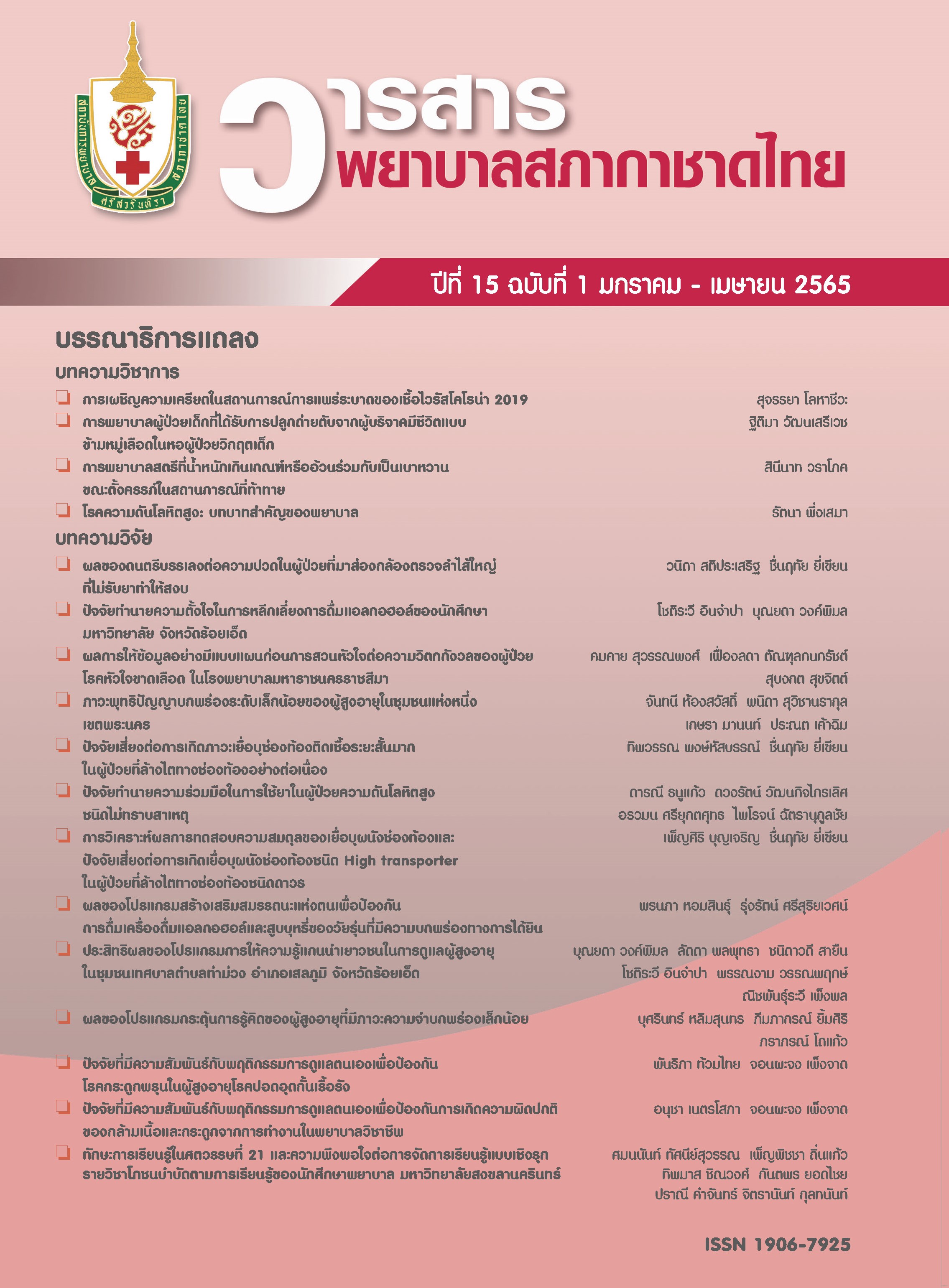Analysis of Peritoneal Equilibration Test and Risk Factors of High Transporter in Patients Undergoing Continuous Ambulatory Peritoneal Dialysis
Keywords:
peritoneal equilibration test, patients with CAPD, PD Nurse, risk factors, high transporter peritoneal membrane permeabilityAbstract
The peritoneal equilibration test (PET test) is one of the most important tools used to identify the appropriate treatment of continuous ambulatory peritoneal dialysis (CAPD) patients. The prospective cohort research aimed to analyze the PET in patients undergoing CAPD from February to May 2019, and risk factors associated to high transporter peritoneal membrane permeability. This study was conducted at Queen Savang Vadhana Memorial Hospital. The standard PET was done. Data were analyzed using statistical software. Descriptive statistics were frequency and percentage. The Chi-square test was used to compare the percentage between the different groups. The risk factors associated to high transporter were determined using risk ratio (RR) and the 95% confidence interval (95%CI). A p value less than .05 was considered as statistical significance.
There were 60 CAPD patients in this study. The groups of patients were selected for their ability to remove waste products of peritoneal based on plasma creatinine ratio (D/PCr). The subjects were divided into 3 groups of patients: low average (48.3%), high average (40.0%) and high transporter (11.7%). There were no patients in the low transporter group. For the ultrafiltration of peritoneal showed dialysate to glucose ratio (D/D0glucose), the study found that there were 4 groups of patients: high average (46.7%), low average (31.7%), high transporter (16.7%) and low transporter (5.0%).
There were two factors associated to high transporter peritoneal type: using a high concentrate dialysate (42.9% vs. 7.5%, p = .006, RR = 5.68 (95%CI = 1.60, 20.28)) and ultrafiltration less than or equal to 100 milliliters (42.9% vs. 8.2%, p = .001, RR = 8.25 (95%CI = 2.52-26.97)).
The recommendations for nursing care in peritoneal dialysis patients regarding peritoneal type from PET test were as follows: the high transporter which has low ultrafiltration, therefore the hypervolumia must be prevented. For the low transporter, which has high ultrafiltration but low elimination of waste products, the uremia must be prevented.
References
Ong-ajyooth L, Vareesangthip K, Khonputsa P, Aekplakorn W. Prevalence of chronic kidney disease in Thai adults: a national health survey. BMC Nephrol 2009;10:35. doi: 10.1186/1471-2369-10-35.
Thanakitcharu P. Current situation of chronic kidney disease in Thailand. Journal of the Department of Medical Services 2015;2(5):5-17. (in Thai)
Twardowski ZJ, Nolph ND, Khanna R, Prowant BF, Ryan LP, Moore HL, et al. Peritoneal equilibration test. Perit Dial Bull 1987;7:138-47.
Kanjanabuch T, editor. Text book of practical peritoneal dialysis. Bangkok: Siri Wattana Interprint; 2013. (in Thai)
Uncanin S, Rasić S, Rebić D, Dzemidzić J, Muslimović A, Begović B, et al. The importance of using peritoneal equilibration test for the peritoneal transport type characterization in continuous ambulatory peritoneal dialysis patients. Bosn J Basic Med Sci 2010;10(S1):S40-3.
The Nephrology Society of Thailand. Guideline 11. Peritoneal Equilibration Test: PET. In: Sirivongs D, editor. Clinical practice guidelines for peritoneal dialysis. Bangkok: The Nephrology Society of Thailand; 2007. p. 45-8. (in Thai)
Mehrotra R, Ravel V, Streja E, Kuttykrishnan S, Adams SV, Katz R, et al. Peritoneal equilibration test and patients outcomes. Clin J Am Soc Nephrol 2015;10(11):1990-2001.
Thitiarchakul S, editor. Peritoneal dialysis. Bankok: Book Net; 2011. (in Thai)
Huang N, Chen J, Fan L, Zhou Q, Xu Q, Xu R, et al. High peritoneal transport status was not associated with mortality in peritoneal dialysis patients with diabetes. PLoS ONE 2014;9(10):e110445. doi: 10.1371/journal.pone.0110445
Johnson DW, Mudge DW, Blizzard S, Arndt M, O’Shea A, Watt R, et al. A comparison of peritoneal equilibration tests performed 1 and 4 weeks after PD commencement. Perit Dial Int 2004;24:460-5.
Churchill DN, Thorpe KE, Nolph KD, Keshaviah PR, Oreo-poulos DG, Page D. Increased peritoneal membrane transport is associated with decrease patient and technique survival for continuous peritoneal dialysis patients. The Canada-Usa (CANUSA) Peritoneal Dialysis Study Group. J Am Soc Nephrol 1998;9:1285-92.
Khanna R. Peritoneal inflammation and high transport status. Clin J Am Soc Nephrol 2006;1:167-9.
La Milla A, Di Filippo S, Crepaldi M, Vecchio LD, Dell’Oro C, Andrulli S, et al. Mini-peritoneal equilibration test: a simple and fast method to assess free water and small solute transport across the peritoneal membrane. Kidney Int 2005;68:840-6.
Kaitwatcharachai C, Aden J, Kongkid K, Kitpiboonchai T, Kaitwatcharachai S. Determination of peritoneal membrane transport characteristics with dialysis adequacy and transport test in Thai patients. J Med Assoc Thai 2011;94(Suppl. 4):S81-6.
Khansamree O. Professional nurses' competencies in caring of peritoneal dialysis patients, government hospitals [Thesis]. Bangkok: Chulalongkorn University; 2009. (in Thai)
Ukati K, Chantajirakhovit N. Self-care agency and quality of life in end stage renal disease patients undergoing continuous ambulatory peritoneal dialysis. Songlkla Med J 2007;25(3):171-7. (in Thai)
Krejcie RV, Morgan DW. Determining sample size for research activities. Educ Psychol Meas 1970;30(3):607-10.
Johnson DW, Hawley CM, McDonald SP, Brown FG, Rosman JB, Wiggins KJ, et al. Superior survival of high transporters treated with automated versus continuous ambulatory peritoneal dialysis. Nephrol Dial Transplant 2010;25(6):1973-9.
Akonur A, Sloand J, Davis I, Leypoldt J. Icodextrin simplifies PD therapy by equalizing UF and sodium removal among patient transport types during long dwells: a modeling study. Perit Dial Int 2016;36(1):79-84.
Eiam-ong S, Tungsanga K, Praditpornsilpa K, editor. Bangkok: Text and Journal Publication; 2002. (in Thai)
Downloads
Published
Issue
Section
License
Copyright (c) 2022 Srisavarindhira Thai Red Cross Institute of Nursing

This work is licensed under a Creative Commons Attribution-NonCommercial-NoDerivatives 4.0 International License.
เนื้อหาบทความหรือข้อคิดเห็นต่างๆ ในวารสารพยาบาลสภากาชาดไทยนี้ เป็นความคิดเห็นของผู้เขียนบทความ ไม่ใช่ความเห็นของกองบรรณาธิการ หรือสถาบันการพยาบาลศรีสวรินทิรา สภากาชาดไทย






